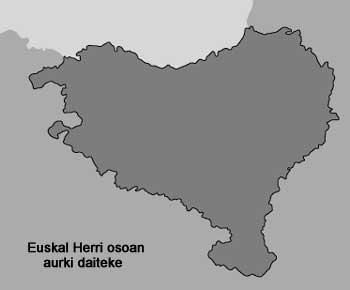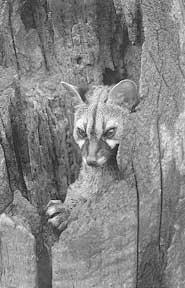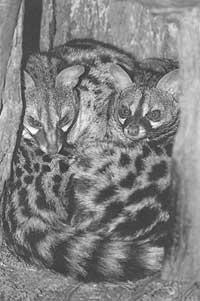Common catajineta, tropical hunter

The bottle family is a heterogeneous group of carnivores made up of 35 species that live mainly in Africa and South Asia, and thanks to their silent and nocturnal customs, as well as the clove with excellent camouflage, their lifestyle is quite unknown, unless we take into account some observations made in laboratories.
The only bottle in southwestern Europe (and therefore the Basque Country) is the common catajineta (Genetta genetta), which, like the other species that are grouped in the same genus, is a medium-sized mammal shaped like a feline. His body is elongated and his short legs, and his long black scars on a clear grey nail form a totally cryptic coloration, imperceptible to the light of the moon. Its velvety tail, marked by its dark rings, has an eye-catching ornament of the same length as the dress, which helps both adjust to the model of cryptic coloration (distorting the appearance of the animal's body) and its valuable organ of balance that goes up and down the branches of the trees.

Long face, sharp end, large ears, binocular vision... The intense gaze of the animal dressed with strict sense organs reflects its character of prey. The presence of sharp retractable nails like cats on the fingers gives us an account of their hunting life, but unlike felines, the katajineta has five fingers on each foot.
But what do the catajinetas, members of the tropical family of the bottles, do in southwestern Europe? According to some researchers, these animals entered the hand of the Arabs. Other authors highlight that the European distribution of the Catajineta is that corresponding to the natural population, with the northern specimens smaller than those of the south, so the European catajinetas would be heirs of the ancient natural colonization. These animals entered the Iberian peninsula through the eternal island, before the expansion of the Strait of Gibraltar.
Katajineta is a very fast and powerful predator that leads an arboreal life, and if you have to go down to the ground to get a piece you are not ashamed. But as in most carnivores, the Cakhineta does not live on pure hunting either and its diet is quite variable throughout the year. In spring and summer it is mainly dedicated to the capture of passerine birds, which make up half of their diet. In autumn and winter, on the other hand, it exploits the fruits without excess hunting. Rodents, for their part, feed throughout the year, and feed on lizards, frogs, bats and other hunting pieces.

The work day of the katajineta begins when it darkens and ends at dawn. During the day it is quiet in some trunk hole, soil cavity or squirrel nest and does not move through it, except for the transfer of rest.
It is a solitary animal that does not need large territories to live. In Africa, for example, 1-2 specimens live in a km2, being the territory of each specimen of 0.25 km2. Here, however, the densities are lower and according to the observations made on the peninsula, each grain has an area of 5 km2. However, these values are quite relative in practice. Females are much slower than males, who have much more mobility.
On the other hand, to claim ownership of the territory, they use special odour marks, of great social importance, that allow to distinguish the identity of the animal, its kinship, its sex and age. These odor marks are usually urine, stool, and secretions from an organ called a fetide gland. Feces are long and rolled structures formed by hairs and feathers that are always left in the same places, that is, in the areas of excrement. They are areas where a lot of excrement is concentrated over time, which denotes the presence of this animal.

The Catajineta is abundant in the Basque Country, although its secret life is known by few people. From sea level to high mountains, at 1,700 m altitude in the Pyrenees. As for its habitat, of course, it likes the forest, and it can be said that it is similar in both leafy and conifers. However, the katajineta has not always been so common, and as with other animals, man has also had a fatal enemy for his fondness of the skin. Currently the Cakhineta is protected and cannot be hunted.
On the other hand, this bottle has such fertility that it has multiplied rapidly by protecting itself. In fact, in Africa catajinetas can proliferate throughout the year. In Europe, for their part, they reproduce especially in April and towards September, covering from 2 to 4 offspring each time (and after 70 days of gestation). In newborns the young are blind and have a length of only 13-14 cm. It takes 8 days to open your eyes, but soon you will leave the hole wanting to know the new world. The mother will feed them by giving them a stop for six months and until they reach the year they will live with him or in their environment, reaching their sexual maturity with the second year.
Technical data sheet KATAJINETA Species: Genetta gen<unk> Family: |
Buletina
Bidali zure helbide elektronikoa eta jaso asteroko buletina zure sarrera-ontzian











